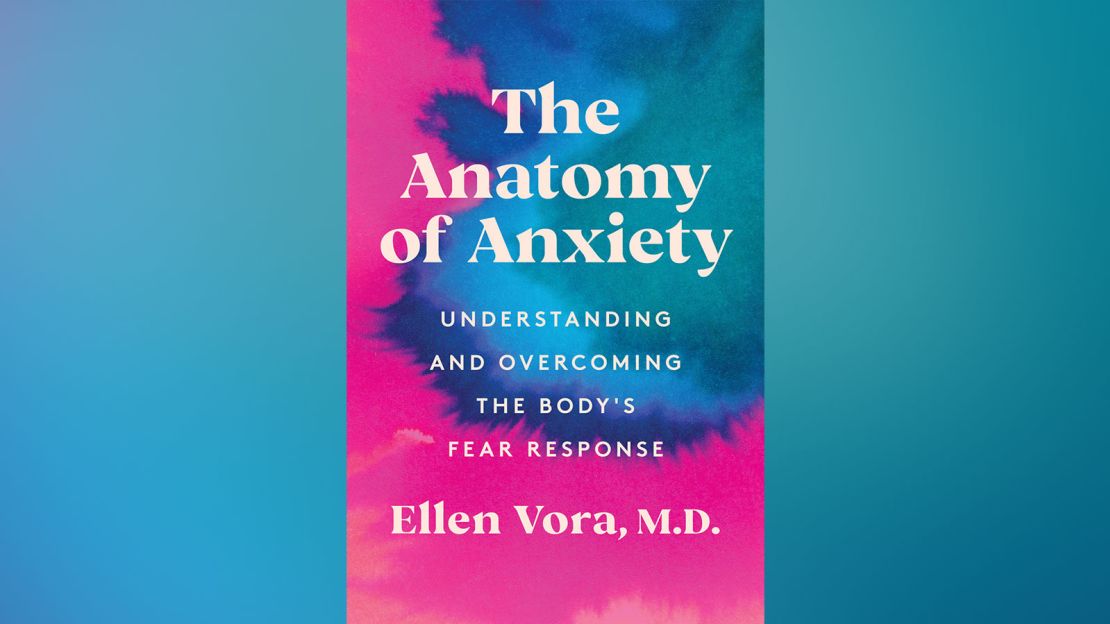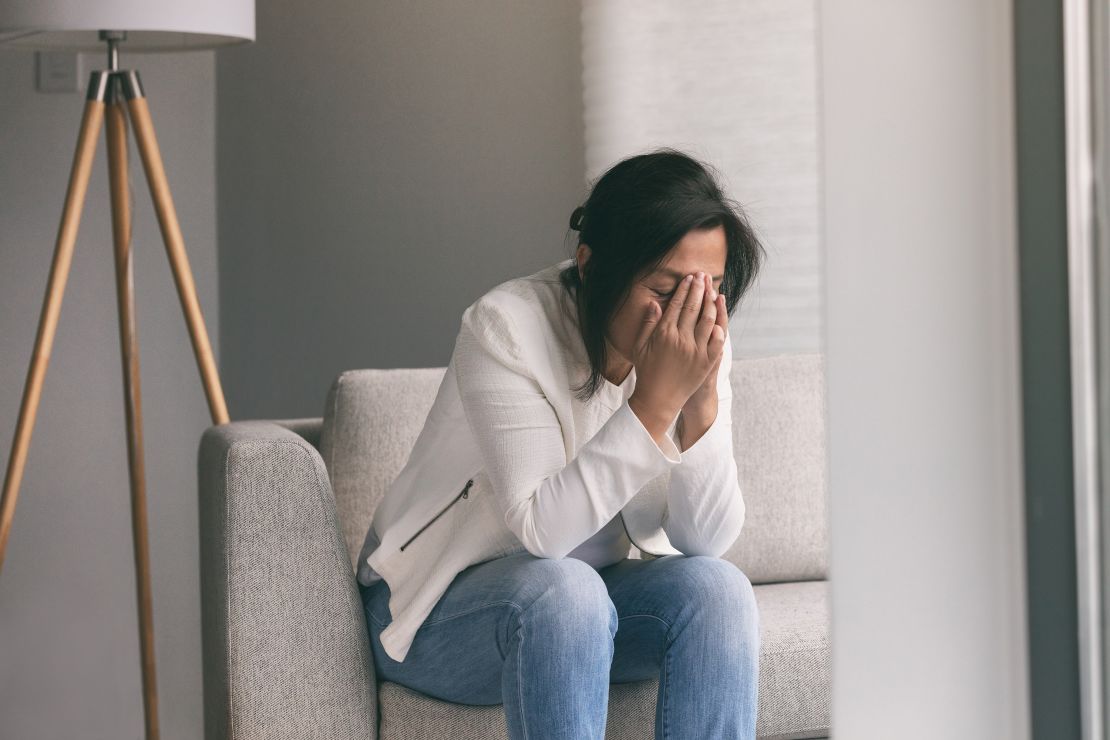April is Stress Awareness Month. Sign up for CNN’s Stress, But Less newsletter and learn how to cope. Our six-part mindfulness guide will inform and inspire you to reduce stress while learning how to harness it.
In recent years, public figures openly sharing their mental health struggles have helped lift fellow sufferers out of silent shame and stigma.
A few decades earlier, the introduction of new medications to treat depression and anxiety disrupted the depiction of mental health problems as a personal failing in favor of an expression of brain chemistry.
Today, new understandings of the reciprocal communication between mind and body make anxiety far more preventable than previously known.
In “The Anatomy of Anxiety: Understanding and Overcoming the Body’s Fear Response,” holistic psychiatrist Dr. Ellen Vora unpacks the physiological underpinnings of stress and fear and shares pioneering strategies for both prevention and treatment.

This conversation has been edited and condensed for clarity.
CNN: What’s the biggest misunderstanding people have about anxiety?
Dr. Ellen Vora: Anxiety is not simply a genetic chemical imbalance. It’s largely based in the state of the physical body, which is something we can change.
Recognizing what I call “false anxiety” allows us to take steps to get our body into a better balance, which helps ease anxiety symptoms. This is the hopeful, empowering message I want to convey.
CNN: How does the mind-body connection impact anxiety?
Vora: Today, many people recognize that mental health impacts the body. They understand top-down messaging – that a thought like, “Oh, no, I have a test tomorrow!” could impact their physical body, say, with an upset stomach.

Less widely recognized is the delicate and deeply interconnected web of back-and-forth communication between body and mind.
Modern life assaults our digestive tract through chronic stress, processed food and pesticides. The compromised ecosystem of bacteria in our digestive system leads to an unhealthy, inflamed gut lining, which triggers a message to the brain, “Things are not OK down here.” When our physical body is out of balance, it tells our brain to feel anxious.
CNN: How has your investigation of anxiety informed your perspective on depression?
Vora: Many patients in my practice have both depression and anxiety. Sometimes they toggle between them. Other times the two states coexist. Chronic anxiety can deplete us over time, leaving us in a hollowed-out state of depression. Both are manifestations of the brain saying, “I’m not OK.”
CNN: What coping strategies can help?
Vora: When our body gets tripped into a stress response, it can feel synonymous with anxiety and panic. First, we must eliminate avoidable “false anxiety” through focusing on nourishment and restorative sleep while monitoring the effects of technology, caffeine and alcohol.

Oftentimes, I like to start with stabilizing blood sugar because it has such a quick impact on our day-to-day anxious feelings.
The modern American diet is built on a foundation of refined carbs and milkshakes disguised as coffee drinks. We end up on this roller coaster of blood sugar spikes chased by insulin, followed by blood sugar crashes that can feel identical to anxiety. Stabilizing blood sugar offers powerful relief from both anxiety and the sense of doom and unease that many people carry in the pit of their stomach.
The definitive solution, to eat a blood sugar-stabilizing diet with fewer refined carbohydrates and more protein and healthy fats, is a lovely strategy. But if that’s 180 degrees from how you’re eating now, here’s a short-term fix: Every few hours, eat a spoonful of sunflower, almond or other nut butter, ghee or coconut oil. This creates a safety net that can blunt any blood sugar crash. Many patients have told me this intervention alone stopped their panic attacks.
CNN: You advise some patients to eat more meat. Why?
Vora: A lot of patients come to me only eating smoothies, matcha lattes, chia seed pudding or big salads. Their constant shakiness comes from their diet lacking substance. A semi-vegetarian diet where meat is not the centerpiece but more of a condiment is probably a sweet spot for wellness.
Panic attacks and a sense of always feeling on edge can stem from a body never getting grounded with adequate nutrition. A warming, nourishing and well-rounded diet can ease symptoms of both anxiety and depression.
CNN: If you could wave a magic wand, what nutrition protocols would your patients adopt?
Vora: I don’t want to encourage people down the path toward feeling fragile, obsessive or fearful about food. That’s not helping anybody’s anxiety. Generally speaking, I encourage people to err on the side of eating real food and avoiding fake, processed food.
The idea is to approach food the way your great-great-great-grandmother’s culture did, by eating a balance of minimally processed protein, carbohydrates and healthy fats, and generally eating what’s local and in season. If you come from a mixture of different lines of ancestry, pick and choose and then listen to your body.
Generally, what works for our bodies echoes where on the planet we descended from. Overall, try to eat real food that was grown with integrity, ideally on small, sustainable farms with humane animal husbandry practices rather than large factory farms and concentrated animal feeding operations.
CNN: What does “completing the stress cycle” mean, and why is it important?
Vora: Balancing your nervous system is critically important to regulating anxiety.
Feeling anxious or going into panic happens when your system tips past the zero mark into a stress response. Stress is inevitable, of course. Many of us have accumulated a lifetime of it yet fail to complete the stress cycle by releasing the pent-up energy.
Animals seem to know instinctively how to discharge the spike in adrenaline they’ve experienced and reset the nervous system. After an antelope has a life-or-death encounter, it shakes. When a goose comes away from an altercation, it flaps its wings in a particular way.
We, as socialized humans, have no shortage of stressors, but we often lack a practice for releasing the lingering effects. For some of my patients, exercise fits the bill. I’m all for any kind of creative expression: singing, dancing, chanting, drawing, journaling, therapy, processing, talking, cuddling, playing with a dog, having a belly laugh or having a good ugly cry. All of these reset our body, telling it, “The threat has passed and now I’m safe.”
I practice the weirdest of all: shaking. To reset my nervous system, I put on shamanic drum music, close my eyes and let my body move for about 90 seconds. Afterward, I’m not carrying the same stress.
It also increases my awareness of what my body is trying to communicate to me. After I shake, I sit in meditation. Usually something I’ve been unconsciously ignoring but need to pay attention to bubbles up.
True anxiety comes from our body’s attempts to communicate. We need to listen.
CNN: What breath practice do you recommend for calming anxiety?
Vora: My go-to is the 4-7-8 breath. Without straining, gently inhale for a count of four, hold for seven and exhale for eight. With anxiety, it’s important to have a loose, easy grip on these structured practices. Feeling like you have to control the breath perfectly is counter-therapeutic.
Typically, our breath is rapid and shallow as we inhale more strongly than we exhale. But if we’re on vacation, lying on a hammock without a care in the world, our respiration will slow to deep diaphragmatic breathing.
Breathing as if we’re relaxed sends a transmission up to the brain along the vagus nerve. It tells our brain the organism is calm, causing a neuro-hormonal cascade that helps relax our whole body.
This practice is easy, free, takes just 30 seconds, and you can do it just about anywhere.
CNN: How long does the effect last?
Vora: Until real life sets in again! Seriously, I think of this, and other relaxation practices, as a multivitamin. The more time in a day that you can put your body into a relaxation response, the farther your body will need to “travel” to rise over the zero line into stress.
Regularly galvanizing relaxation throughout your day creates a habit, establishing familiarity with a state of calm that we can come back to as needed.
It’s as if you create a peaceful destination where, in almost any moment, your mind and body can return to rest and reset.
Jessica DuLong is a Brooklyn, New York-based journalist, book collaborator, writing coach and the author of “Saved at the Seawall: Stories From the September 11 Boat Lift” and “My River Chronicles: Rediscovering the Work That Built America.”




